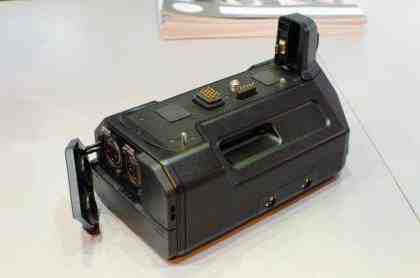We are big fans of the Panasonic Lumix GH3 . This Micro Four Thirds camera had the controls and handling of a professional camera, mixed with excellent image quality. We were excited to see what Panasonic could muster for its follow-up, the GH4.
While we were expecting the GH4 to make improvements and tweaks to the GH3, the introduction of a 4K video shooting mode rather took us by surprise. With this mode, the GH4 is looking like a great contender to be the perfect enthusiast video and stills camera.
PANASONIC LUMIX GH4 4K SHOOTING
The ability to shoot 4K video truly is the stand-out feature on the GH4. The good news is that it really is proper 4K, with the GH4 able to shoot at the 4K cinema resolution of 4,096x2,160 at 24p. It also supports the TV Ultra HD standard of 3,840x2,160 at 24p, 25p and 30p.
One concern was that the camera would use a low bit rate in order to keep file sizes down, but it's safe to say that this isn't the case and the GH4 can shoot 4K video at a staggering 100Mbit/s. We've seen test footage shot on the camera and, while this kind of footage is always shot to make the camera look as good as possible, we have to say that it looked fantastic. For 1080p video you can go even further, shooting at a staggering 200Mbit/s. This mode uses ALL-Intra, where each frame is captured and compressed individually - in other words, the video is made up of individual 1080p images; interframe (IPB) uses intraframes at set intervals, with intervening frames just recording the changes in the frames. We can't wait to get the camera in to find out if the higher bit rate makes any difference over the 50Mbit/s mode.
If you want to review 4K footage straight from the camera, it has an HDMI 1.4 output, which supports footage up to 30fps - the limitation of the camera's ability.
SD USH SPEED CLASS 3 (U3) MEMORY CARDS
High bit rates and large file sizes will require memory cards that are fast enough, but Panasonic has this covered, too, with its SDXC and SDHC UHS-I cards. The Gold Series cards comply with UHS Speed Class 3 (U3), which means they have a minimum write speed of 240Mbit/s (30MB/s). Peak speeds are higher, with read speeds of up to 90MB/s and write speeds of up to 45MB/s, which means that copying files to and from the memory card should be super-quick.

U3 memory cards have the speed for 4K high-bit-rate videos
PANASONIC LUMIX GH4 XLR DOCK
Panasonic is clearly making a push for the GH4 to be used professionally, as it will sell an optional dock (the DMW-YAGH Interface Unit for GH4) that attaches to the bottom of the camera. This adds dual XLR inputs, with an audio level display monitor and +48V of phantom power for each channel. There's even professional time coding available and a full-size HDMI port.

It also provides quad-link SDI for 4K video in 4:2:2 10-bit, and dual-link 4:2:2 10-bit 1080p video. Recording at 10-bit means that the camera can't simultaneously record to memory card, though.

The awkwardly named DMW-YAGH pushes the GH4 into professional territory
We haven't seen it in operation yet, but this is the kind of dock you wouldn't necessarily expect from a camera of this type. It could well propel the GH4 into professional territory.
PANASONIC LUMIX GH4 STILL PHOTOS
Inside the camera hasn't changed much, but there are improvements. For starters, although the resolution of the sensor hasn't been upped from the previous model's 16.05-megapixels, it is a brand-new sensor. Panasonic claims the result is less noise and wider dynamic range.
Image processing has also been increased, with a quad-core CPU and a new Venus engine image processor. A lot of this improved processing is to cope with 4K video, but it has a knock-on effect with still images, too. This lets the camera shoot at 40fps (using the electronic shutter), up from 20fps on the GH3. ISO sensitivity has also been increased, moving from a maximum of ISO 12,800 to ISO 25,600.
PANASONIC LUMIX GH4 HANDLING AND FEATURES
We're pleased to say that Panasonic hasn't done much to the build quality or handling of the camera, leaving the GH3's controls pretty much intact. The mode dial is a little chunkier on the GH4 and that bit easier to grab, but all of the other controls remain the same.

It's good to see that the dual control dials remain, so most of the camera's features are only a finger away.
Build quality remains excellent. As we noted in our original GH3 review, this camera looks a feels like a serious bit of kit. It rivals the best DSLRs and fits extremely comfortably in the hands. The GH4 has an upgraded EVF. The OLED screen has a resolution of 2,539K dots, up from 1,744K dots on the GH3. Using it, we have to say that the new EVF is super-sharp and it made composing shots extremely easy.
On the back, the OLED touchscreen has been upgraded from 614K dots to 1036K dots. That should make composing and viewing pictures that much easier. It's good to see that the screen is still a free-angle model, so you can unclip it and angle it the way you want to shoot pictures from difficult angles.
PANASONIC LUMIX GH4 CONCLUSION
At the time of writing, the GH4 we saw wasn't running final firmware, so it's hard to make any judgement about image quality. However, if the quality matches up to the impressive specs and, what looks like, incredible 4K modes, the GH4 should be a real winner. No price has been announced yet, but we'd expect the new model to cost around the same as the GH3 when it was released. We'll update you with more information as we have it.






Leave a Reply